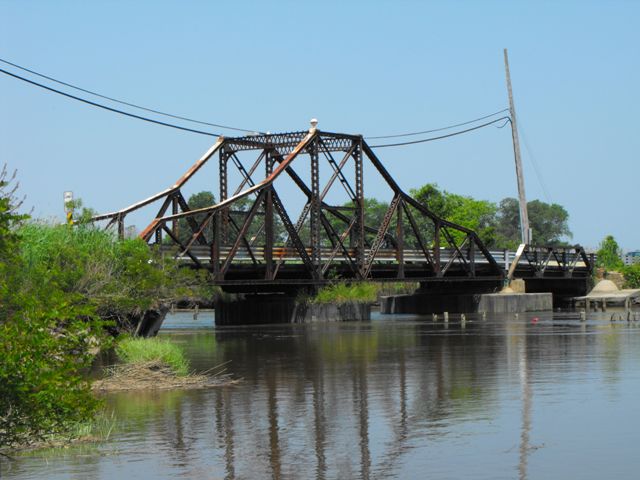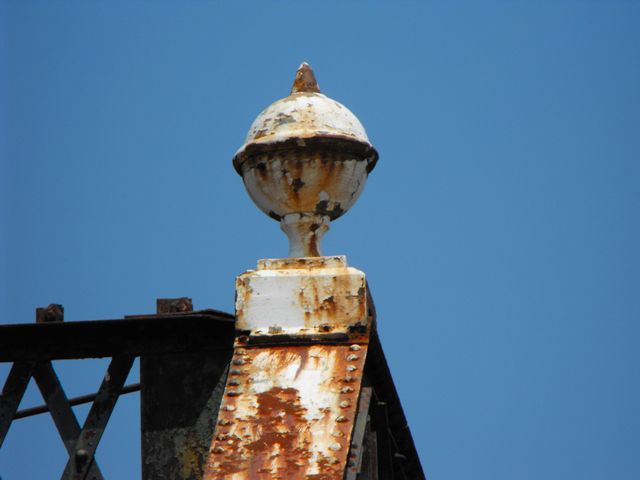We Recommend:
Bach Steel - Experts at historic truss bridge restoration.
BridgeHunter.com Phase 1 is released to the public! - Visit Now
New Bridge

Primary Photographer(s): Nathan Holth and Rick McOmber
Bridge Documented: May 31, 2010
Rural: Salem County, New Jersey: United States
Metal Rivet-Connected Through Truss, Movable: Swing (Center Bearing Center Pier) and Approach Spans: Metal Rivet-Connected Warren Pony Truss, Fixed
1905 By Builder/Contractor: New Jersey Bridge Company of Manasquan, New Jersey
1976
50.0 Feet (15.2 Meters)
153.0 Feet (46.6 Meters)
14.4 Feet (4.39 Meters)
1 Main Span(s) and 1 Approach Span(s)
1701399

View Information About HSR Ratings
Bridge Documentation
This bridge's future is at risk!
Bridge Status: This historic bridge is slated for demolition and replacement!View Archived National Bridge Inventory Report - Has Additional Details and Evaluation
View Historic American Engineering Record (HAER) Documentation For This Bridge
This bridge is a fantastic example of an rural early 20th Century hand-turned center-bearing swing bridge. The bridge was built by an in-state bridge builder of which extremely few remaining examples remain. As such, the bridge is a key part of New Jersey's transportation heritage. The overall shape of the swing truss is one of the least common designs. This bridge once had considerable ornamentation, including portal cresting, builder plaque, and four decorative finials. At the time of documentation, only a couple finials remained. The pony truss approach span was rendered decorative by the addition of stringers under the deck, but the truss itself is unaltered. Otherwise however, the truss bridge itself retained good historic integrity. Although the bridge has not opened for boasts since the 1960s, a lot of the mechanical elements under the bridge still remain. Structurally, the bridge is currently in poor condition but it certainly could be restored, either for light vehicular use or for non-motorized use. Like so many truss bridges, most of the severe deterioration is around the lower chord and associated connections, with the remaining bridge in fair condition.
Unfortunately, Salem County feels that the only way to deal with such a rare and historic bridge is to reduce it to scrap metal and construct an ugly slab of concrete in its place. It is quite striking to see the contrast in historic bridge preservation committment between the northern and southern halves of New Jersey. Northern New Jersey tends to engage in much more preservation of its historic bridges.
There were once two such swing bridges in Salem County, the other one bring the Pedricktown Bridge, but this bridge was demolished by the time HistoricBridges.org visited the county. The Pedricktown Bridge was more heavilly altered, with an approach span replaced, more mechanical parts removed, and more swing truss alterations. That bridge was not found eligible for the National Register, the historic bridge inventory instead pointing to the New Bridge as being the better example and the National Register worthy example. Regardless of the Pedricktown Bridge's significance, when it was demolished, it made the New Bridge even more rare and significant beyond what it already was. Salem County should cancel its demolition plans for the New Bridge and select a preservation alternative. This is Salem County's last chance to preserve a historic swing bridge. Further, the bridge is regionally important to preserve because southern New Jersey has drastically less historic truss bridges (movable or fixed) than the northern half of the state. The preservation of surviving examples of truss bridges in southern New Jersey should thus be given high priority.
Information and Findings From New Jersey's Historic Bridge InventorySummary The bridge is a center-bearing, steel-truss swing span with modified Warren pony truss approach span. The bridge was hand operated and the mechanism is in place, although the bridge has not been opened since the mid-1960s. It has ornamental finials, lattice work, and plaque on the tower. The bridge is the best example of its type in the southern part of the state. It is one of a small handful of documented surviving NJ Bridge Co. bridges in the United States. Setting/Context The single-lane bridge spans a tidal estuary in an undeveloped wetlands near the Delaware Bay. The surrounding area is rural with fields and scattered residences. Physical Description The bridge is a 110'-long, single-lane, wood-decked, center-bearing, steel through truss swing span with a 37'-long, 3-panel, riveted Warren pony truss span on the north side. The main span is a 9-panel truss with a central tower. At the first panel it is 8'- deep, and at the tower it is 22'-deep. The lower chord consists of angles with lacing, and the upper chord of channels with lacing and a cover plate. All connections are riveted. The verticals are laced angles or channels, and the diagonals are channels with battens. The central tower has latticed portals, lateral tie rods, and two of four original urn-shaped finials. Plaques on the tower portals read "1905. Built by New Jersey Bridge Co., Manasquan NJ." The swing span is inoperable, but the operating mechanism remains extant. It is a center-bearing type, hand-powered by a crank attachment inset in the deck. The crank turned a pinion gear against a circular rack. The rack is mounted to the top of the center pier. The bridge was designed to open in either direction, and turns upon a center bearing. A box-shaped system of four girder with four balance wheels supported and balanced the bridge on the center pier when the bridge was in the open position. The south end of the bridge rests on steel rollers with axles perpendicular to the length of the bridge. They were hand operated by levers and designed to lift the bridge in the closed position, lock it in place, and provide it with a footing on the abutment. The swing span has timber pile fenders. It provided a 42'-channel to river navigation, and last opened in the mid-1960s. Numerous alterations have been made to the substructure and the approach span, but none seriously compromise the bridge's overall integrity of design. The original piers and abutments were masonry. In 1925 the center pier was widened and reinforced with concrete. In 1942 the south abutment was rebuilt with concrete, and in 1957 the abutments were raised by approximately 12 inches. In 1966 the northern pier and abutment were reinforced with concrete. In 1976, following a vehicular accident, an end post and portion of the lower chord of the west side of the pony truss were replaced and repairs made to the panel points. A vertical on the east side of swing span was replaced, and the lattice railings were removed and beam guard rails added. In 1979 the approach span was strengthened with the addition of longitudinal steel stringers that effectively relieved the pony trusses of load bearing responsibility. In 1991 the single-lane bridge was closed to vehicular traffic due to safety concerns and structural inadequacies. Historical and Technological Significance The bridge is one of the few documented surviving examples of a bridge constructed by the New Jersey Bridge Company of Manasquan. Although never recognized as a major national bridge builder, the company was a significant in-state manufacturer of highway bridges. The swing span over Alloways Creek is a good representative example of a popular 20thcentury movable span bridge technology that is becoming increasingly rare. It retains integrity of design and of setting. A bridge has spanned Alloways Creek at the site of New Bridge since the early-19th century. In 1905 the Salem County Board of Freeholders decided to replace the worn-out wooden draw bridge with a new steel swing span. They drew specifications for the new bridge and advertised for bids. At a price of $10,200, the NJ Bridge Co. was the lowest bidder of seven companies. The NJ Bridge Co. operated from 1890 to 1907. The company was started by two gentlemen from Canton, Ohio, Mr. Wyckoop and Mr. Braly. The built a 300'-deep, 100'-wide shop in Manasquan on Atlantic Avenue, adjacent the railroad tracks. At the height of their operation they employed 15 to 20 draftsmen and 100 men in the fabricating shop. A local history claims that the company "was the largest individual manufacturing facility ever to have existed in Manasquan." In 1904-1907 the company ran into financial difficulties after securing the contract to build a large swing span, Long Bridge over the Fore River, in Portland, Maine. Unable to meet its obligations and material deliveries, the company went out of business in 1907. The company went into bankruptcy at the end of an era of small, regional, independent, bridge manufacturers. The Manasquan Historical Society owns a series of photographs illustrating the company shops. No known company records survive. According to a local history, many of the bridges built by the NJ Bridge Co. were erected in Middlesex and Monmouth Counties. The company had some national contracts; in addition to the Portland Bridge, which has been demolished, a Pratt truss has been identified in Grand Rapids, Michigan [North Park Street Bridge]. It too is scheduled for replacement. In Salem County a slightly larger, less well-preserved, and similar movable bridge spans Oldmans Creek near Pedricktown (1700199). According to local records, in 1906 the New Jersey-West Virginia Bridge Co. constructed the Pedricktown Bridge based upon the same specifications prepared for the swing span at Alloways Creek. The relationship of the NJ Bridge Company to the NJ-WV Bridge Company is not known, except that it seems a reasonable assumption that the latter was a merger or buy-out intended to save the former from bankruptcy. Boundary Description and Justification Although the unspoiled setting contributes to the character of the well-preserved bridge, it is the structure itself that is evaluated as significant. The boundary is thus limited to the bridge, substructure and superstructure, of the approach span and the movable span themselves. Sources Hool, George A. and W. S. Kinne, eds. Movable and Long Span Bridges. New
York: McGraw-Hill, 1923. Bridge Considered Historic By Survey: Yes |
![]()
Photo Galleries and Videos: New Bridge
Structure Overview
Original / Full Size PhotosA collection of overview photos that show the bridge as a whole and general areas of the bridge. This gallery offers photos in the highest available resolution and file size in a touch-friendly popup viewer.
Alternatively, Browse Without Using Viewer
![]()
Structure Details
Original / Full Size PhotosA collection of detail photos that document the parts, construction, and condition of the bridge. This gallery offers photos in the highest available resolution and file size in a touch-friendly popup viewer.
Alternatively, Browse Without Using Viewer
![]()
Structure Overview
Mobile Optimized PhotosA collection of overview photos that show the bridge as a whole and general areas of the bridge. This gallery features data-friendly, fast-loading photos in a touch-friendly popup viewer.
Alternatively, Browse Without Using Viewer
![]()
Structure Details
Mobile Optimized PhotosA collection of detail photos that document the parts, construction, and condition of the bridge. This gallery features data-friendly, fast-loading photos in a touch-friendly popup viewer.
Alternatively, Browse Without Using Viewer
![]()
Maps and Links: New Bridge
Coordinates (Latitude, Longitude):
Search For Additional Bridge Listings:
Bridgehunter.com: View listed bridges within 0.5 miles (0.8 kilometers) of this bridge.
Bridgehunter.com: View listed bridges within 10 miles (16 kilometers) of this bridge.
Additional Maps:
Google Streetview (If Available)
GeoHack (Additional Links and Coordinates)
Apple Maps (Via DuckDuckGo Search)
Apple Maps (Apple devices only)
Android: Open Location In Your Map or GPS App
Flickr Gallery (Find Nearby Photos)
Wikimedia Commons (Find Nearby Photos)
Directions Via Sygic For Android
Directions Via Sygic For iOS and Android Dolphin Browser
USGS National Map (United States Only)
Historical USGS Topo Maps (United States Only)
Historic Aerials (United States Only)
CalTopo Maps (United States Only)


